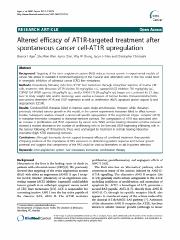Please use this identifier to cite or link to this item:
https://ahro.austin.org.au/austinjspui/handle/1/11294| Title: | Altered efficacy of AT1R-targeted treatment after spontaneous cancer cell-AT1R upregulation. | Austin Authors: | Ager, Eleanor I;Wen, Shu Wen;Chan, Joyna;Chong, Way W;Neo, Jaclyn H;Christophi, Christopher | Affiliation: | The Department of Surgery, Austin Health, The University of Melbourne, Heidelberg, VIC, Australia | Issue Date: | 26-Jun-2011 | Publication information: | Bmc Cancer 2011; 11(): 274 | Abstract: | Targeting of the renin angiotensin system (RAS) reduces tumour growth in experimental models of cancer. We aimed to establish if combined targeting of the 'classical' and 'alternative' arms of the RAS could result in synergistic inhibition of colorectal cancer (CRC) liver metastases.Immediately following induction of CRC liver metastases through intrasplenic injection of murine CRC cells, treatment with irbesartan (AT1R blocker; 50 mg/kg/day s.c.), captopril (ACE inhibitor; 750 mg/kg/day i.p.), CGP42112A (AT2R agonist; 0.6 μg/kg/hr i.p.), and/or ANG-(1-7) (24 μg/kg/hr i.p.) began and continued for 21 days. Liver to body weight ratio and/or stereology were used as a measure of tumour burden. Immunohistochemistry was used to determine AT1R and VEGF expression as well as proliferation (Ki67), apoptosis (active caspase 3) and angiogenesis (CD34).Combined RAS therapies failed to improve upon single arm therapies. However, while irbesartan previously inhibited tumour growth in this model, in the current experiments irbesartan failed to affect tumour burden. Subsequent analysis showed a cancer-cell specific upregulation of the angiotensin II type I receptor (AT1R) in irbesartan-insensitive compared to irbesartan-sensitive tumours. The upregulation of AT1R was associated with an increase in proliferation and VEGF expression by cancer cells. While animals bearing irbesartan-sensitive tumours showed a marked decrease in the number of proliferating cells in the liver and VEGF-expressing infiltrating cells in the tumour following AT1R treatment, these were unchanged by treatment in animals bearing irbesartan-insensitive (high AT1R expressing) tumours.Although the results do not support increased efficacy of combined treatment, they provide intriguing evidence of the importance of RAS expression in determining patient response and tumour growth potential and suggest that components of the RAS could be used as biomarkers to aid in patient selection. | Gov't Doc #: | 21703011 | URI: | https://ahro.austin.org.au/austinjspui/handle/1/11294 | DOI: | 10.1186/1471-2407-11-274 | Journal: | BMC cancer | URL: | https://pubmed.ncbi.nlm.nih.gov/21703011 | Type: | Journal Article | Subjects: | Adenocarcinoma.drug therapy.genetics.metabolism.secondary Angiotensin I.pharmacology.therapeutic use Angiotensin II Type 1 Receptor Blockers.pharmacology.therapeutic use Angiotensin-Converting Enzyme Inhibitors.pharmacology.therapeutic use Animals Biphenyl Compounds.pharmacology.therapeutic use Captopril.pharmacology.therapeutic use Colorectal Neoplasms.drug therapy.genetics.metabolism Drug Resistance, Neoplasm Drug Screening Assays, Antitumor Drug Synergism Gene Expression Regulation, Neoplastic Liver Neoplasms, Experimental.drug therapy.genetics.metabolism Mice Mice, Inbred CBA Molecular Targeted Therapy Neoplasm Proteins.antagonists & inhibitors.physiology Neovascularization, Pathologic.drug therapy Oligopeptides.pharmacology Peptide Fragments.pharmacology.therapeutic use Receptor, Angiotensin, Type 1.biosynthesis.drug effects.genetics Receptor, Angiotensin, Type 2.agonists Renin-Angiotensin System.physiology Tetrazoles.pharmacology.therapeutic use Tumor Burden Tumor Markers, Biological Up-Regulation Vascular Endothelial Growth Factor A.biosynthesis.genetics |
| Appears in Collections: | Journal articles |
Files in This Item:
| File | Description | Size | Format | |
|---|---|---|---|---|
| 21703011.pdf | 2.95 MB | Adobe PDF |  View/Open |
Page view(s)
40
checked on Apr 26, 2025
Download(s)
110
checked on Apr 26, 2025
Google ScholarTM
Check
Items in AHRO are protected by copyright, with all rights reserved, unless otherwise indicated.
